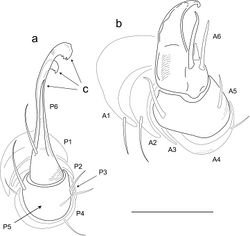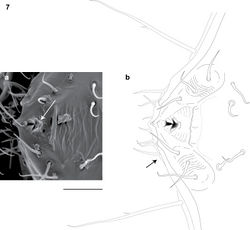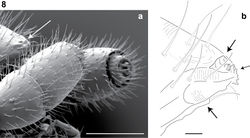Illacme
| Notice: | This page is derived from the original publication listed below, whose author(s) should always be credited. Further contributors may edit and improve the content of this page and, consequently, need to be credited as well (see page history). Any assessment of factual correctness requires a careful review of the original article as well as of subsequent contributions.
If you are uncertain whether your planned contribution is correct or not, we suggest that you use the associated discussion page instead of editing the page directly. This page should be cited as follows (rationale):
Citation formats to copy and paste
BibTeX: @article{Marek2012ZooKeys241, RIS/ Endnote: TY - JOUR Wikipedia/ Citizendium: <ref name="Marek2012ZooKeys241">{{Citation See also the citation download page at the journal. |
Ordo: Siphonophorida
Familia: Siphonorhinidae
Name
Illacme Cook & Loomis, 1928 – Wikispecies link – Pensoft Profile
- IllacmeCook and Loomis 1928[1]: 12; Chamberlin and Hoffman 1958[2]: 189; Buckett 1964[3]: 29; Jeekel 1971[4]: 39; Hoffman 1980[5]: 116; Shelley 1996b[6]: 23; Shelley 1996a[7]: 1808; Hoffman 1999[8]: 195; Jeekel 2001[9]: 46; Marek and Bond 2006[10]: 707; Shelley 2010[11]: 45.
Type species
Illacme plenipes Cook and Loomis 1928[1]: 12; by original designation.
Family placement
Illacme is placed with other taxa in the family Siphonorhinidae based on the following characters: Head pear-shaped (♂) or triangular (♀), not elongate or bird beak-shaped, as in the Siphonophoridae (Fig. 2, Morphbank 805574, Appendix I). Antennae elbowed between antennomeres 3, 4 (Fig. 3, Mb-805578). Antennomeres 5, 6 with apical dorsal cluster of 7 or 8 basiconic sensilla (Bs2) in slight depression, not deep-set into circular pits, as in the Siphonophoridae (Fig. 4, Mb-805575). Posterior gonopods with distal podomere divided into 2 or 3 branches (Fig. 5, Mb-805576, Fig. 6c). See also diagnoses of Illacme in Shelley (1996b, p. 23) and of Siphonorhinidae in Shelley and Hoffman (2004, p. 218).
Diagnosis
Adults of Illacme are distinct from other siphonorhinid genera (and commonly-encountered millipedes co-occurring with Illacme plenipes) based on the combination of – Exoskeleton: Body light cream-colored, thread-like, extremely narrow and long (max. width: ♂ 0.55, ♀ 0.64; max. length: ♂ 28.16, ♀ 40.40). Adult individuals with 84 – 192 segments, and with 318 – 750 legs (VMNH paratype ♀ with 192 segments and 750 legs, more than any other organism known on Earth). Body with hirsute vestiture, appearing velvety (Fig. 2, Mb-805577). Antennae elbowed between antennomeres 3, 4 (Figs 2, 3, Mb-805578). Antennomeres 5, 6 enlarged, appearing oversized relative to other millipedes (Figs 2, 3, Mb-805579). Head pear-shaped (♂) or triangular/chevron-shaped (♀), eyeless (Figs 2, 3, Mb-805574, Appendix I). Mouthparts (gnathochilarium, mandibles) and labrum tightly appressed, tapered anteriorly to rounded apex, not bird beak-shaped, as in the Siphonophoridae (Fig. 3, Mb-805586). Labrum with triangular tooth-lined orifice (Fig. 7a, b; Mb-805580). Denticulate shelf-like carina, projecting dorsally from labrum-epistome margin (Fig. 8a, b; Mb-805588). Internal anatomy. Posterior one-quarter length of enteron loosely spiraled; when alive, visible through translucent cuticle (Fig. 9, Mb-805582). Male gonopods. 9th and 10th leg pairs modified into gonopods, each comprising 6 podomeres (Fig. 6a, b). Anterior gonopod thick, more robust than posterior gonopod (Fig. 10, Mb-805583, Fig. 6b). Anterior gonopodal apex (podomere 6, Fig. 6a, A6) shovel-shaped; in repose, cupped sheath-like around flagelliform posterior gonopodal apex (podomere 6, Fig. 11, Mb-805584, Fig. 6b, P6). Posterior gonopodal podomere 6 divided, comprising a bundle of 3 stylus-shaped articles (Fig. 5, Mb-805627, Fig. 6a, P6); remaining siphonorhinid taxa have 2 stylus-shaped articles with a small spine (Nematozonium filum) or 2 articles without a spine (Siphonorhinus Pocock, 1894 species and Kleruchus olivaceus Attems, 1938). 2 dorsal-most, longest articles of P6 laminate distally and recurved laterally, with denticulate posterior margins appearing claw-like (Fig. 12, Mb-805585, Fig. 6a, P6). Ventral-most, shortest article of P6 acuminate distally, spike-like. Habit in life. Movement very slow, nearly imperceptible (Appendix II, III). Antennae movement rapid, independent. Terminal antennomeres held flat and rapidly tap substrate and surroundings (Appendix IV).
Taxon Treatment
- Marek, P; Shear, W; Bond, J; 2012: A redescription of the leggiest animal, the millipede Illacme plenipes, with notes on its natural history and biogeography (Diplopoda, Siphonophorida, Siphonorhinidae) ZooKeys, 241: 77-112. doi
Other References
- ↑ 1.0 1.1 Cook O, Loomis H (1928) Millipeds of the order Colobognatha, with descriptions of six new genera and type species, from Arizona and California. Proceedings of the United States National Museum 72: 1-26.
- ↑ Chamberlin R, Hoffman R (1958) Checklist of the millipeds of North America. Bulletin of the United States National Museum 212: 1-236. doi: 10.5479/si.03629236.212
- ↑ Buckett J (1964) Annotated list of Diplopoda of California. Simmons Publishing Co., Davis, California, 34 pp.
- ↑ Jeekel C (1971) Nomeclator generum et familiarum Diplopodorum: A list of the genus and family-group names in the class Diplopoda from the 10th edition of Linneaus, 1758, to the end of 1957. Monografieën van de Nederlandse Entomologische Vereniging 5: 1-412.
- ↑ Hoffman R (1980) “1979” Classification of the Diplopoda. Muséum d’histoire naturelle, Genève, 237 pp.
- ↑ Shelley R (1996b) The milliped order Siphonophorida in the United States and northern Mexico. Myriapodologica 4: 21-33.
- ↑ Shelley R (1996a) A description of Siphonophora portoricensis Brandt (Diplopoda: Siphonophorida: Siphonophoridae), with a catalogue of ordinal representatives in the New World. Journal of Natural History 30: 1799-1814. doi: 10.1080/00222939600771051
- ↑ Hoffman R (1999) Checklist of millipeds of North and Middle America. Virginia Museum of Natural History, Martinsville, VA, 584 pp.
- ↑ Jeekel C (2001) A bibliographic catalogue of the Siphonophorida (Diplopoda). In: Jeekel C (Ed). Myriapod Memoranda. C.A.W. Jeekel, Amsterdam, Netherlands: 44-71.
- ↑ Marek P, Bond J (2006) Rediscovery of the world’s leggiest animal. Nature 441: 707-707. doi: 10.1038/441707a
- ↑ Shelley R (2010) Rediscovery, redescription, and illustrations of the milliped, Mitocybe auriportae Cook and Loomis, 1928 (Colobognatha: Platydesmida: Andrognathidae). Zootaxa 2475: 39-47.
Images
|





